My definition of 'bearish' is different from yours 🧸
Plus a charted review of the macro crosscurrents 🔀
📈The stock market rallied to all-time highs, with the S&P 500 setting an intraday high of 6,764.58 on Thursday and a closing high of 6,753.72 on Wednesday. On Friday, the S&P dropped 2.7%. The index is now up 11.4% year-to-date. More on market volatility below…
-
If you follow business news, you’ll regularly see financial professionals, bank CEOs, and other pundits warn that the stock market is likely to fall in the near future.
Most of these calls predict a decline ranging from about 5% to 15%. More than a modest pullback but not quite the 20%+ decline of a bear market.
Are these calls “bearish”? It depends on who you ask. Most market watchers would say any prediction of decline is “bearish.”
Not me!
Expecting a drawdown that falls short of an outright bear market while prices are near record highs doesn’t meet my definition of being “bearish.” (I explained this two weeks ago on the RenMac Off-Script podcast. Watch here at the 48-minute mark.)
In fact, I would argue that expecting such declines in the near term is a critical part of a thoughtful, longer-term bull thesis because these moves happen all of the time.
As this classic chart from JPMorgan’s Guide to the Markets shows, the S&P 500 has experienced an average intra-year max drawdown (i.e., a decline from its high) of 14%. Notably, many big drops occurred in years when the stock market ultimately closed higher!
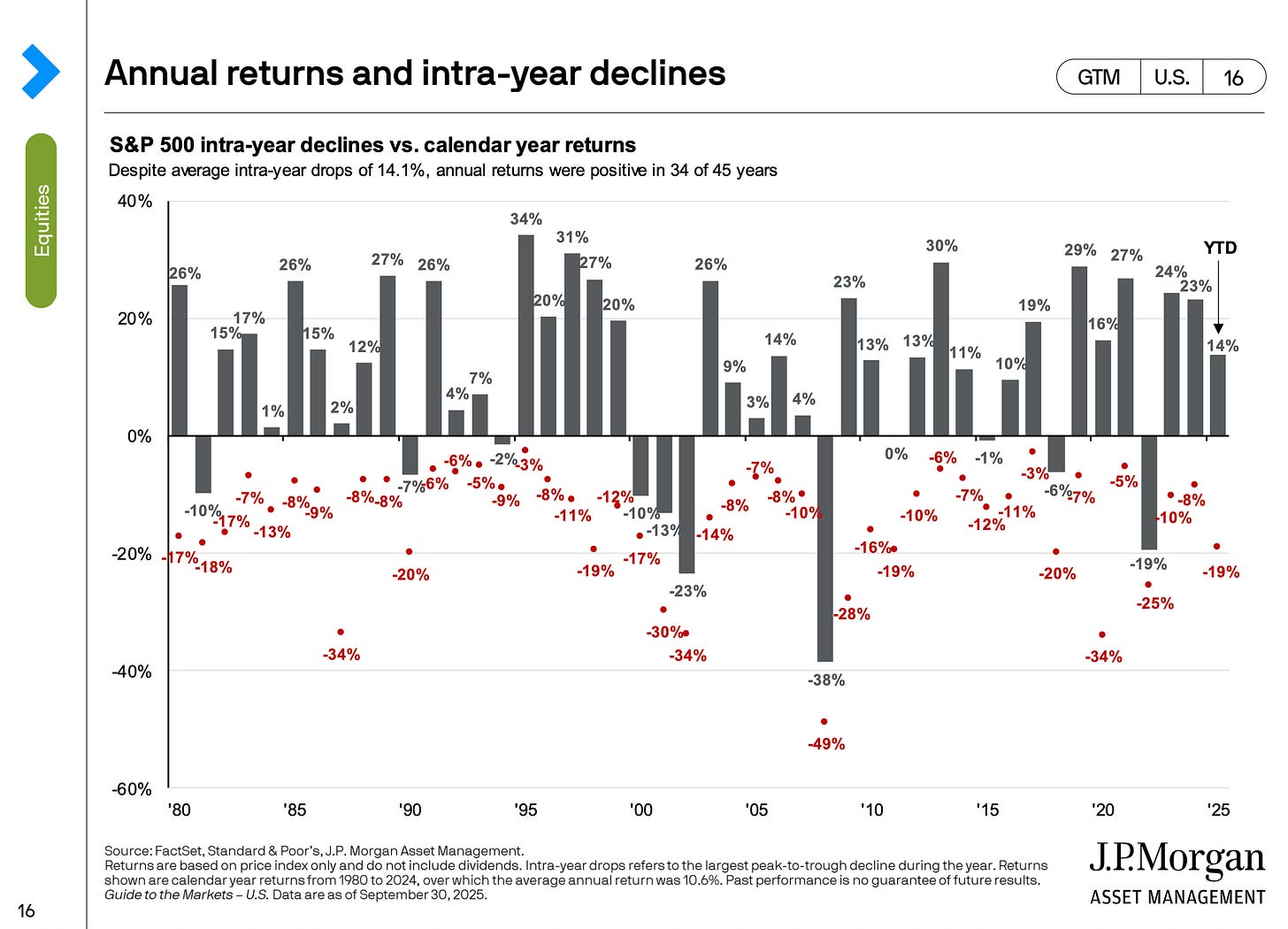
Being a bull doesn’t mean you think the stock market will only go up because the stock market will often fall on its way up.
If you’re an investor and you don’t expect bouts of volatility, you’re more likely to make an emotion-driven, money-losing mistake. It’s why you should always keep your stock market seat belts fastened.
Having said all that, here’s my attempt at some definitions from the perspective of a long-term investor:
bearish: expecting prices to trend lower with intermittent rallies, eventually falling by 20% or more from a recent high
bullish: expecting prices to trend higher with intermittent drawdowns, and eventually climbing by 20% or more from a recent low
In other contexts, such as short-term trading, “bearish” and “bullish” can take on different meanings. I’m writing for long-term investors.
Admittedly, 20% is an arbitrary figure. But it meets the classical definitions of bull and bear markets.
These definitions are a work in progress, and they’re far from complete. I welcome your feedback in the comments section below!
Long-term optimism, short-term cautious optimism 😬
Unfortunately for long-term investors, a 14%-ish drawdown isn’t as bad as it gets.
While a longer investment time horizon improves your odds of generating a positive return, it also increases the likelihood you’ll experience a bear market along the way.
Using history as a guide, the guys on the Animal Spirits podcast illustrated this inconvenient truth in the chart below.
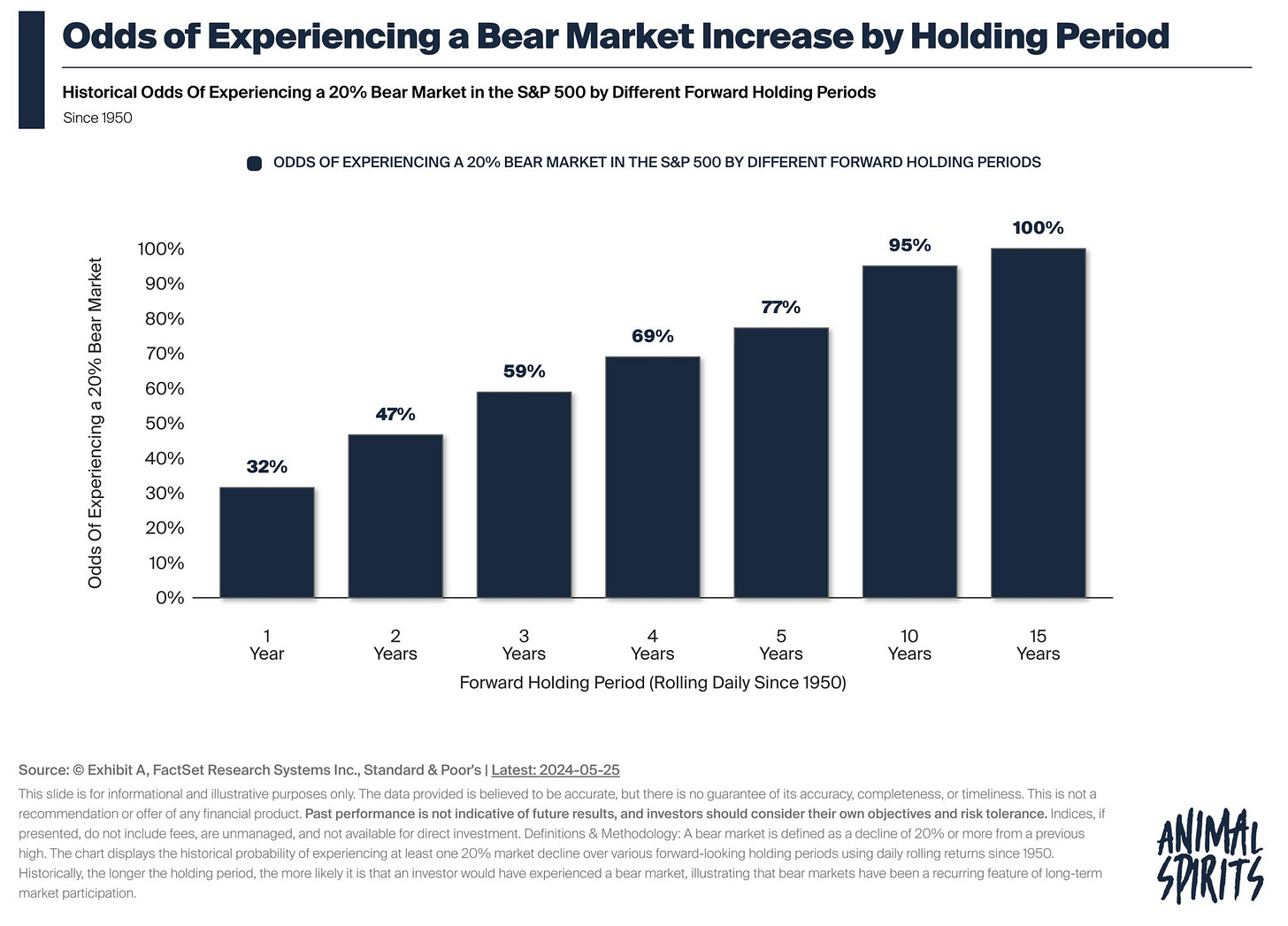
Anyone who’s been in the market in recent years can appreciate this risk. The S&P 500 fell:
20% from September to December 2018.
34% from February to March 2020.
Indeed, investing is an unpleasant process.
The good news is the market is much higher today, which means all of those ugly drawdowns proved to be great buying opportunities.
This is why I say I’m an optimist long term, but a cautious optimist short term.
-
Related from TKer:
My favorite visualization of short-term stock market performance 📊
It’s OK to have emotions — just don’t let them near your stock portfolio 📉
A time-tested way to buy stocks when the market is tumbling 📉
Review of the macro crosscurrents 🔀
There were several notable data points and macroeconomic developments since our last review:
🚨Due to the government shutdown, we are not getting economic data from government agencies, including the Census Bureau, the Bureau of Labor Statistics, and the Bureau of Economic Analysis. Until the government reopens, we’ll be leaning more on private sources of data.
👎 Inflation expectations heat up. From the New York Fed’s September Survey of Consumer Expectations: “Median inflation expectations in September increased at the one-year-ahead horizon to 3.4% from 3.2% and at the five-year-ahead horizon to 3.0% from 2.9%. They remained steady at the three-year-ahead horizon at 3.0%.“
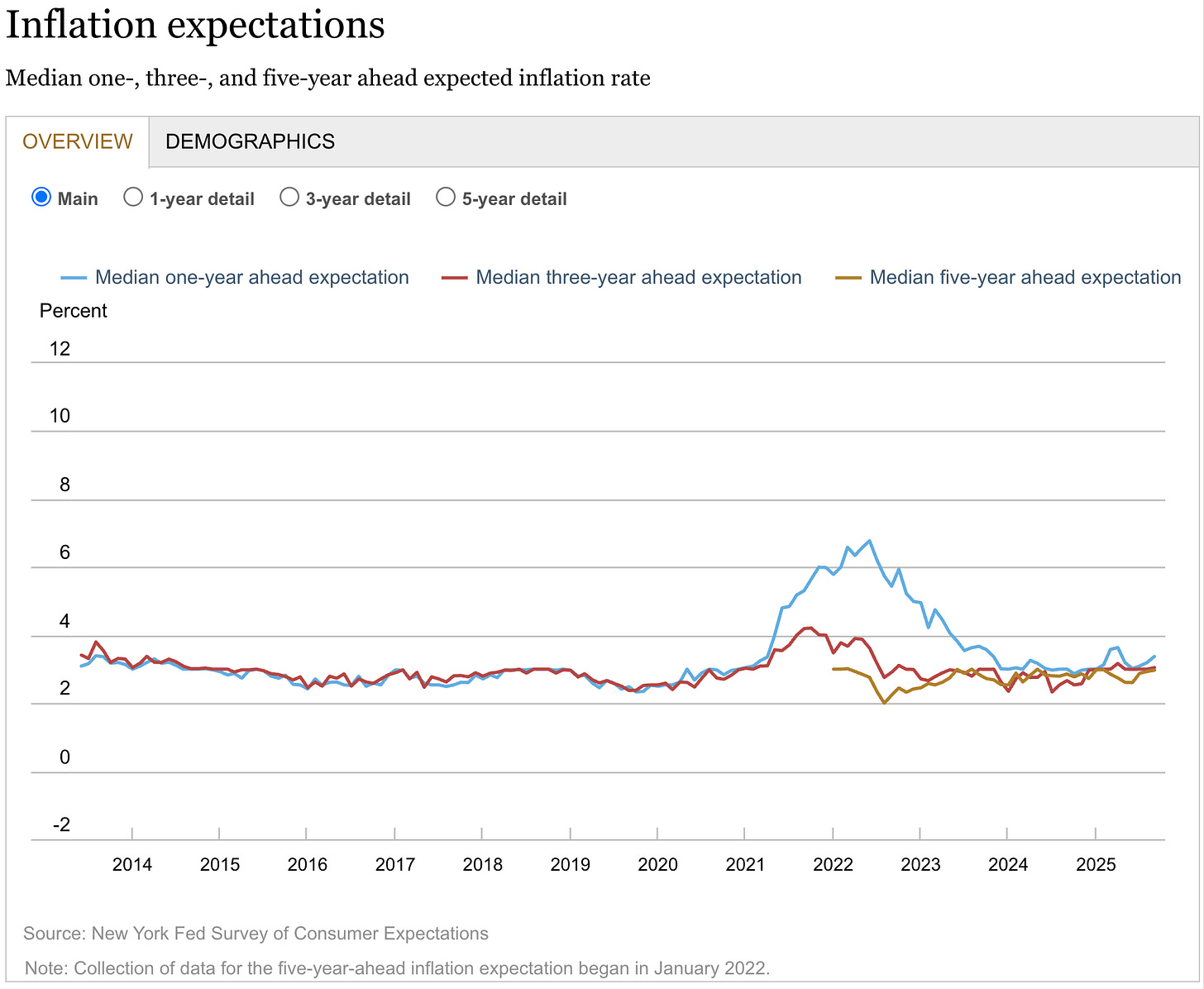
The introduction of new tariffs risks higher inflation. For more, read: 5 outstanding issues as President Trump threatens the world with tariffs 😬
👎 Labor market sentiment slumps. From the New York Fed’s September Survey of Consumer Expectations: “Median one-year-ahead earnings growth expectations decreased by 0.1 percentage point to 2.4% in September, the lowest reading since April 2021. Mean unemployment expectations — or the mean probability that the U.S. unemployment rate will be higher one year from now — increased 2.0 percentage points to 41.1%. The mean perceived probability of losing one’s job in the next 12 months increased by 0.4 percentage point to 14.9%, above the trailing 12-month average of 14.1%.”
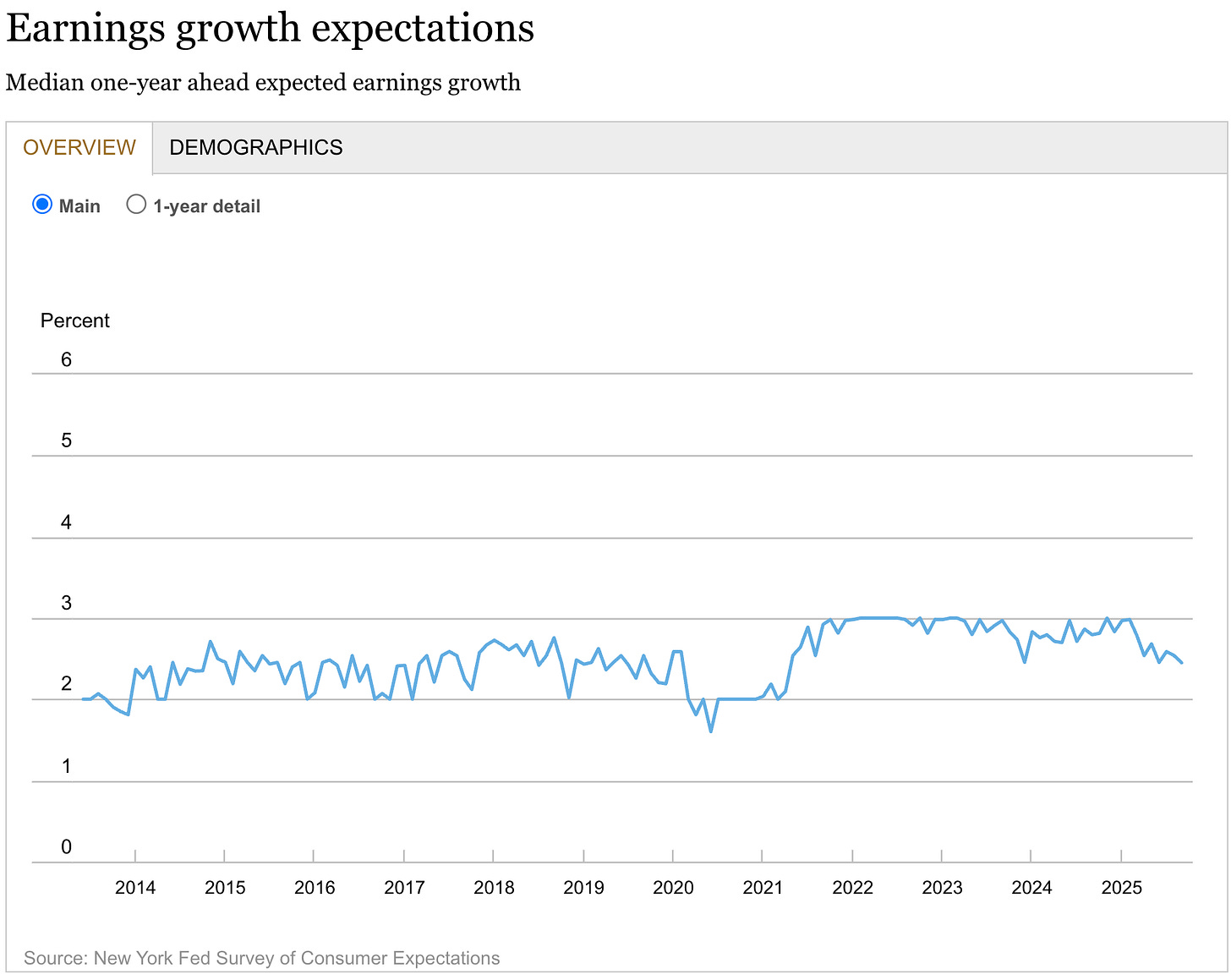
For more on the labor market, read: The economy is barely growing, and recession risk is up 😬
👎 Consumer vibes deteriorate. From the University of Michigan’s October Surveys of Consumers: “Improvements this month in current personal finances and year-ahead business conditions were offset by declines in expectations for future personal finances as well as current buying conditions for durables. Overall, consumers perceive very few changes in the outlook for the economy from last month. Pocketbook issues like high prices and weakening job prospects remain at the forefront of consumers’ minds. At this time, consumers do not expect meaningful improvement in these factors. Meanwhile, interviews reveal little evidence that the ongoing federal government shutdown has moved consumers’ views of the economy thus far.“

Sentiment among those holding a lot of stocks is doing better thanks to the market rally.
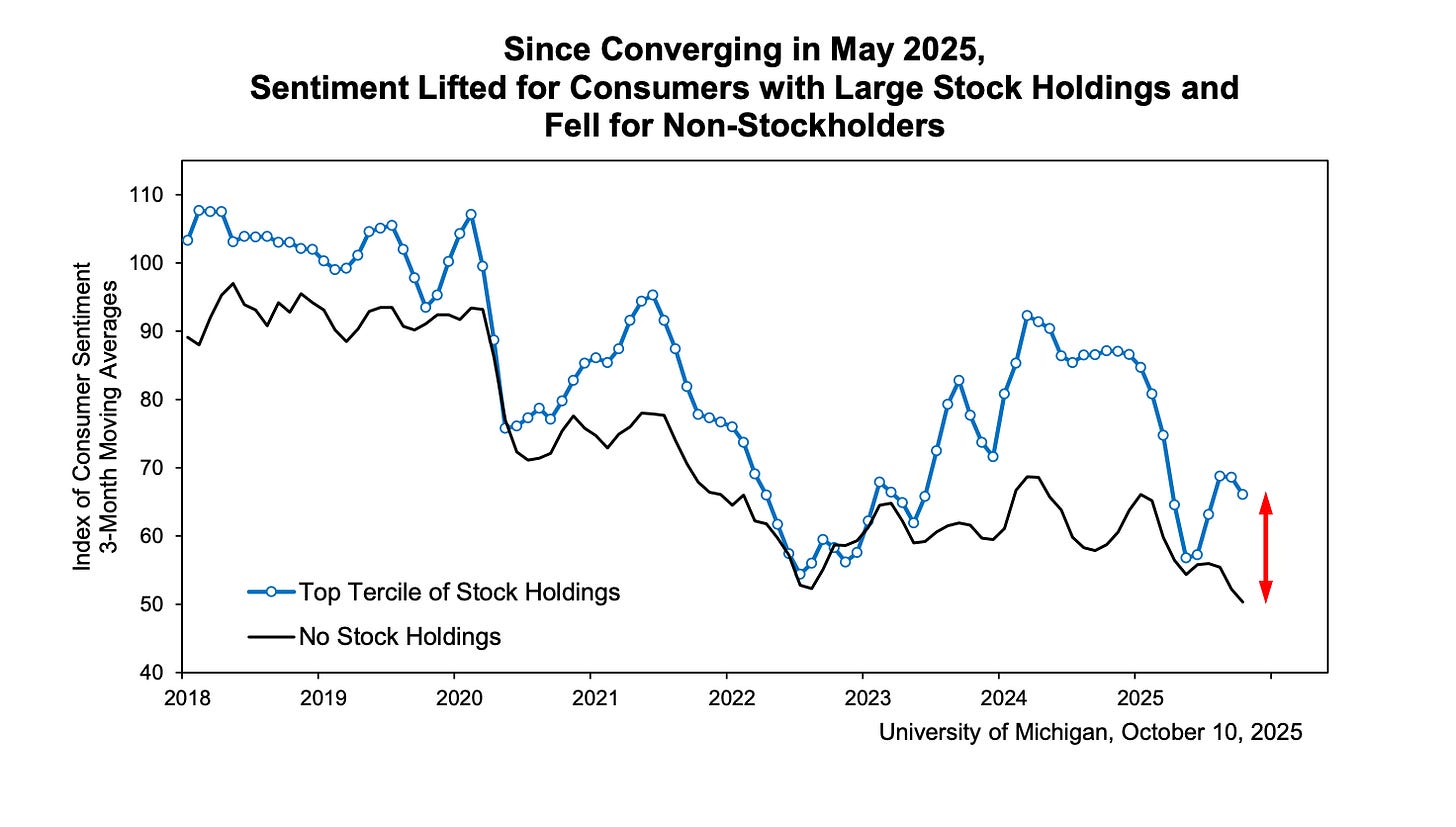
Relatively weak consumer sentiment readings appear to contradict relatively strong consumer spending data. For more on this contradiction, read: What consumers do > what consumers say 🙊 and We’re taking that vacation whether we like it or not 🛫
⛽️ Gas prices tick lower. From AAA: “As autumn sets in, the national average price for a gallon of regular gasoline has dropped to $3.11, down from last week. According to the Energy Information Administration, demand for gasoline has fallen to a four-month low, contributing to the continued decline in pump prices. With the third quarter of 2025 ending in higher gasoline inventories and the seasonal transition from summer-grade to winter-grade fuel, consumers are likely to see even lower prices at the pump in the coming weeks.”
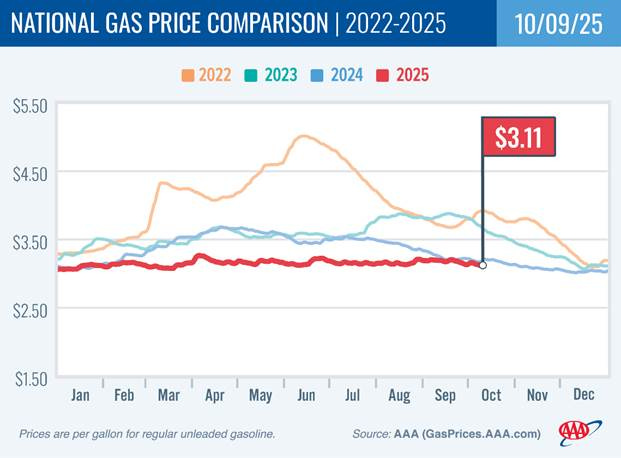
For more on energy prices, read: Higher oil prices meant something different in the past 🛢️
🚗 Used car prices tick lower. From Manheim: “Wholesale used-vehicle prices (on a mix, mileage, and seasonally adjusted basis) were down slightly in September compared to August. The Manheim Used Vehicle Value Index (MUVVI) declined to 207.0, lower by 0.2% versus August levels but showing an increase of 2% from a year ago.“
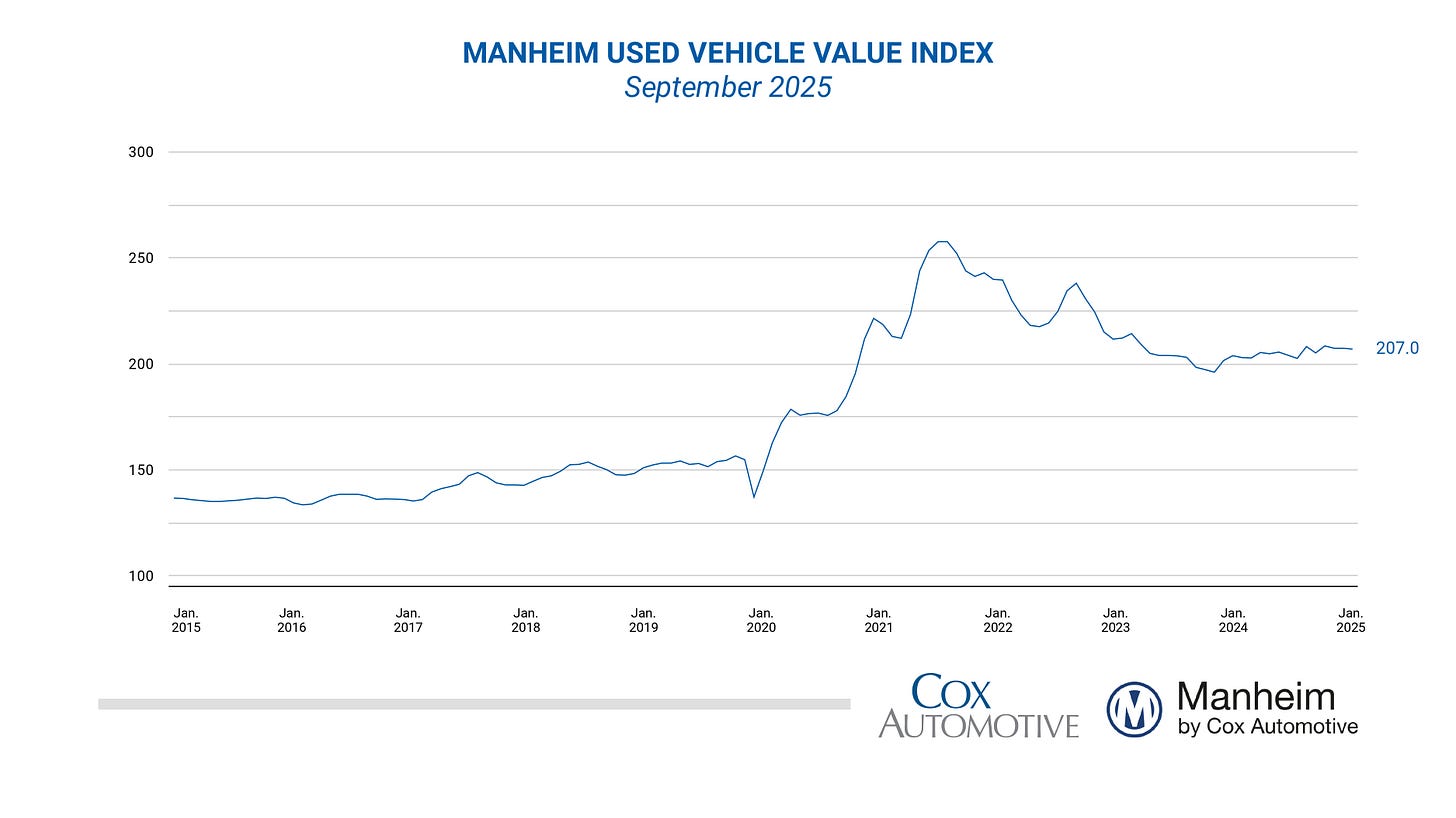
🏦 Bank data suggests the labor market is cooling. BofA’s card data shows cooling job creation in September: “We use Bank of America internal data to estimate a payrolls series by looking at how the number of customer accounts receiving a paycheck is changing. This data can be fairly noisy, partly due to seasonal variation. However, looking at a three-month moving average, Exhibit 1 suggests some further softening in payrolls growth occurred in September.“

The data suggests unemployment is rising: “Using unemployment payments into Bank of America customer accounts as a guide to continuing unemployment claims, Exhibit 2 shows that in October the year-over-year (YoY) percentage rise in unemployment payments was around 10%, compared to a 5% YoY rise in BLS continuing claims in August. In our view, this suggests some upward momentum to unemployment.“
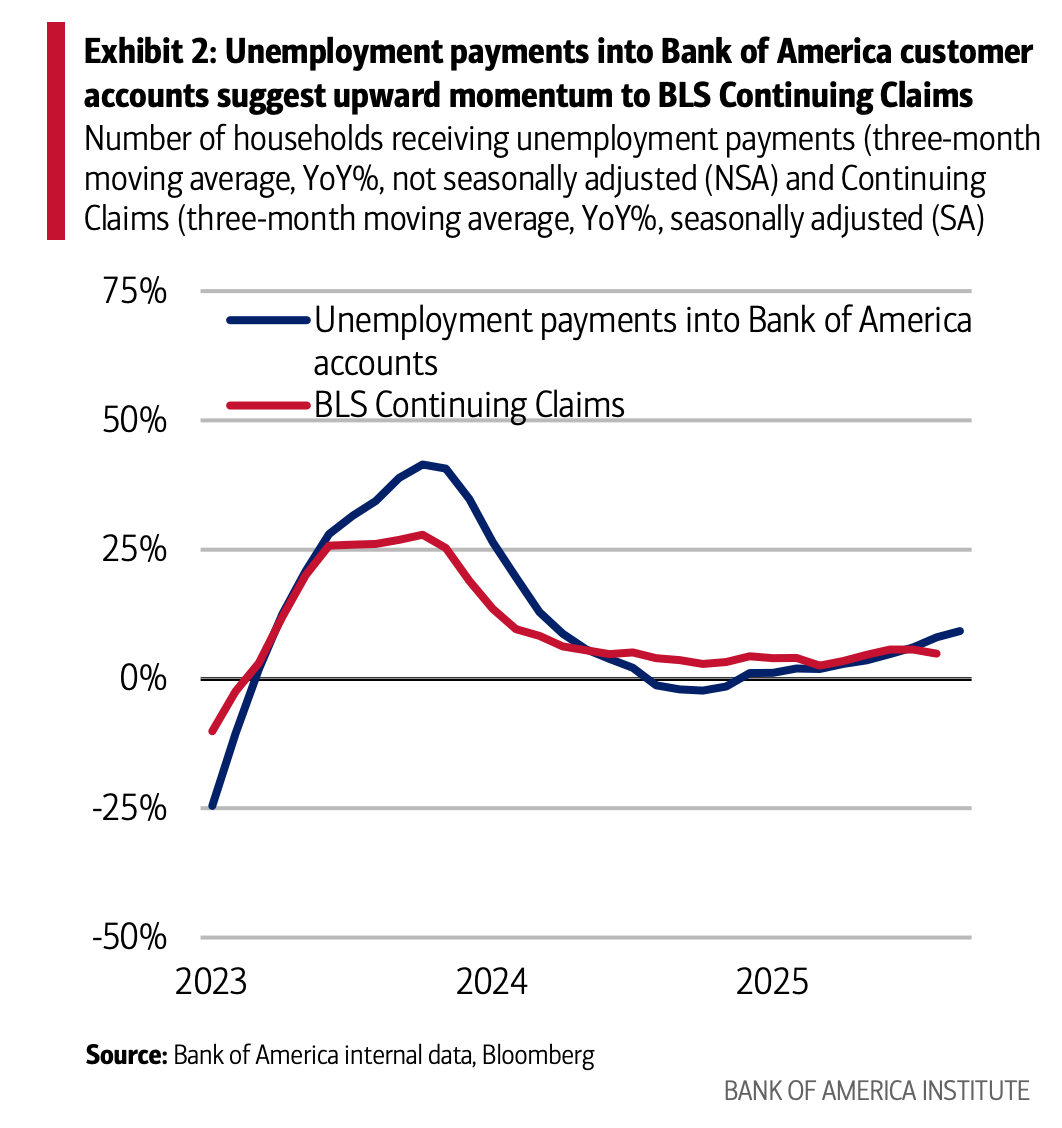
💳 Consumers took on more debt. According to Federal Reserve data, total revolving consumer credit outstanding declined modestly to $1.31 trillion in August. Revolving credit consists mostly of credit card loans. Nonrevolving credit, which includes auto loans and student loans, increased to $3.76 trillion.
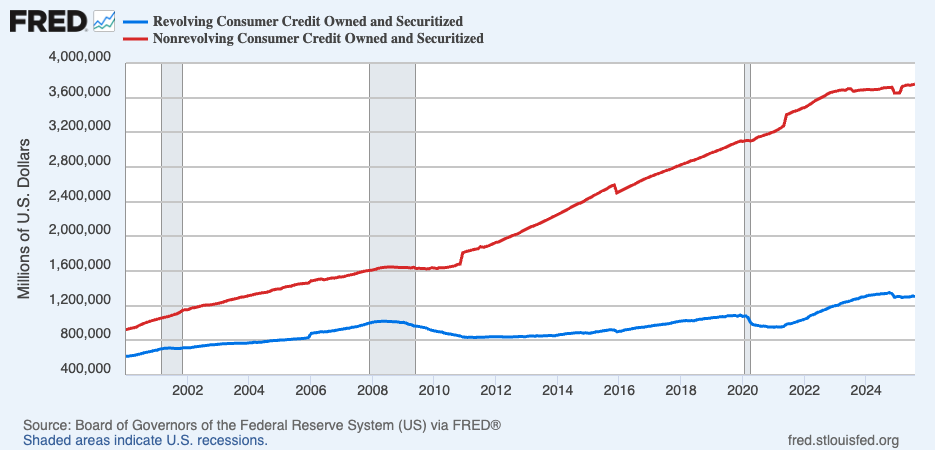
Of course, consumer debt should always be normalized against some form of assets or income.
One of the better metrics capturing the health of the consumer is household debt service payments as a percent of disposable personal income. While this metric remains above its record lows of 2021, it continues to be very strong relative to historical trends, including past economic booms.
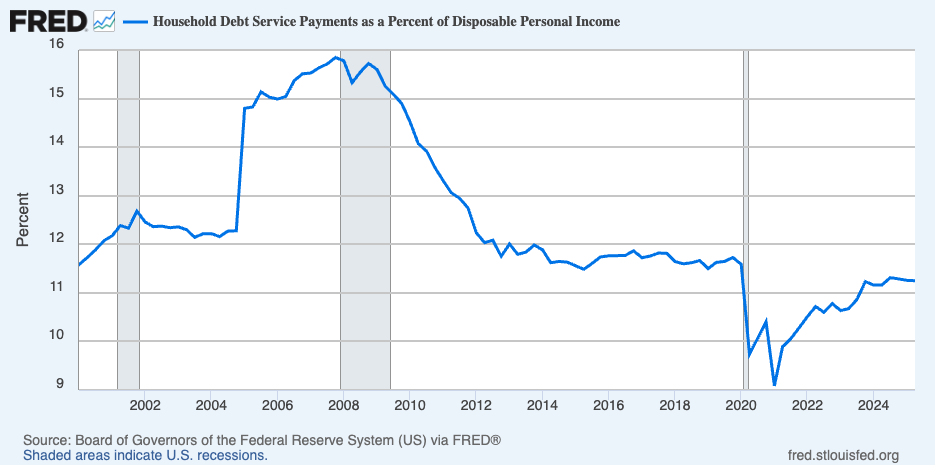
From Wells Fargo: “The good news is when you step back to evaluate the health of household balance sheets, the sector as a whole is still in good financial shape. Overall household net worth expanded by just over 4% in the second quarter, or the most in four years, to $176 trillion and total household debt as a share of disposable income has continued to trend lower sitting just around 82%, a multi-decade low outside temporary pandemic-related distortions. Part of this healthy read on leverage is admittedly owed to the current sturdy position of the U.S. mortgage market, where homeowners own a near-record share of equity in the single-family housing stock and are locked in at ultra-low mortgage rates. But even looking through mortgages, the level of household debt looks manageable in the context of aggregate income.“
For more on consumer financial health, read: Americans have money, and they’re spending it 🛍️
💳 Card spending data is holding up. From JPMorgan: “As of 30 Sep 2025, our Chase Consumer Card spending data (unadjusted) was 2.0% above the same day last year. Based on the Chase Consumer Card data through 30 Sep 2025, our estimate of the US Census September control measure of retail sales m/m is 0.10%.”
From BofA: “Total card spending per HH was up 2.2% y/y in the week ending Oct 4, according to BAC aggregated credit & debit card data. Y/y spending growth saw the biggest increases in airlines, lodging and electronics in the week ending Oct 4. Meanwhile, general merchandise and entertainment had the biggest declines in y/y spending growth.“
For discussion on how sales may be inflated due to tariffs, read: A BIG economic question right now 🤔
🏠 Mortgage rates tick lower. According to Freddie Mac, the average 30-year fixed-rate mortgage declined to 6.30%, down from 6.34% last week: “Mortgage rates decreased this week. Over the last few weeks, mortgage rates have settled in at their lowest level in about a year. There is growing evidence that homebuyers are digesting these lower rates and gradually are willing to move forward with buying a home, which is boosting purchase activity.”
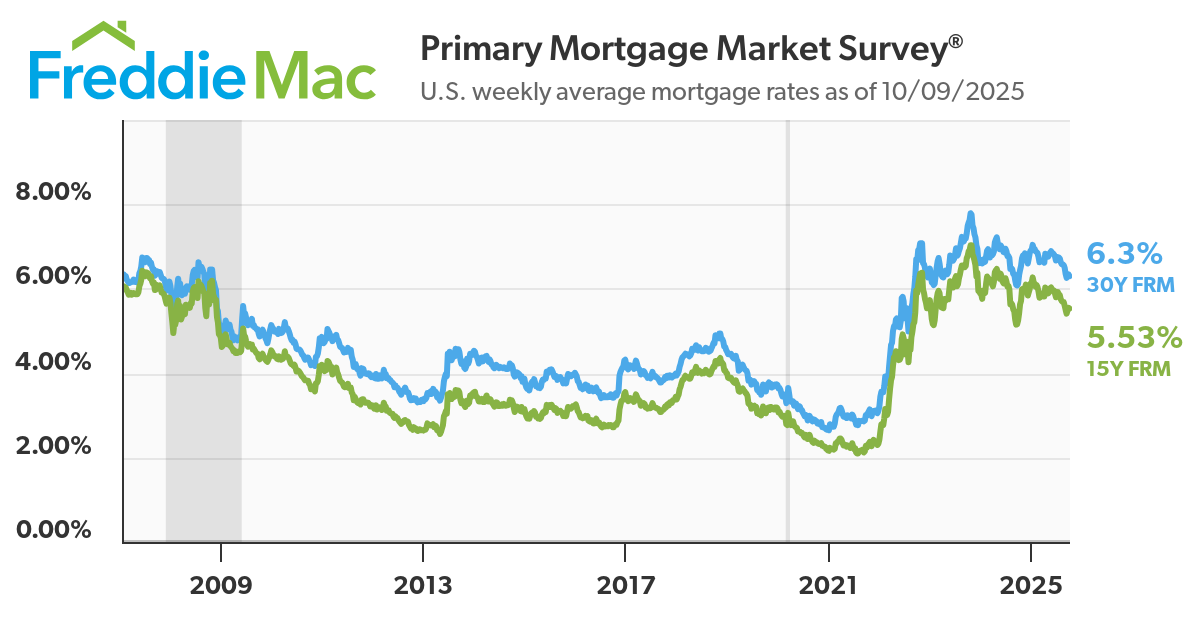
There are 147.9 million housing units in the U.S., of which 86.1 million are owner-occupied and about 39% are mortgage-free. Of those carrying mortgage debt, almost all have fixed-rate mortgages, and most of those mortgages have rates that were locked in before rates surged from 2021 lows. All of this is to say: Most homeowners are not particularly sensitive to the small weekly movements in home prices or mortgage rates.
For more on mortgages and home prices, read: Why home prices and rents are creating all sorts of confusion about inflation 😖
💰 Weekly mortgage applications decline. From Mortgage Bankers Association’s Mike Fratantoni: “With mortgage rates on fixed-rate loans little changed last week, refinance application activity generally declined. Refinance volume remains somewhat elevated relative to levels of a month ago. Purchase activity declined by about 1% for the week but continues to show moderate growth on an annual basis, and stronger growth for FHA loans, favored by first-time homebuyers.”
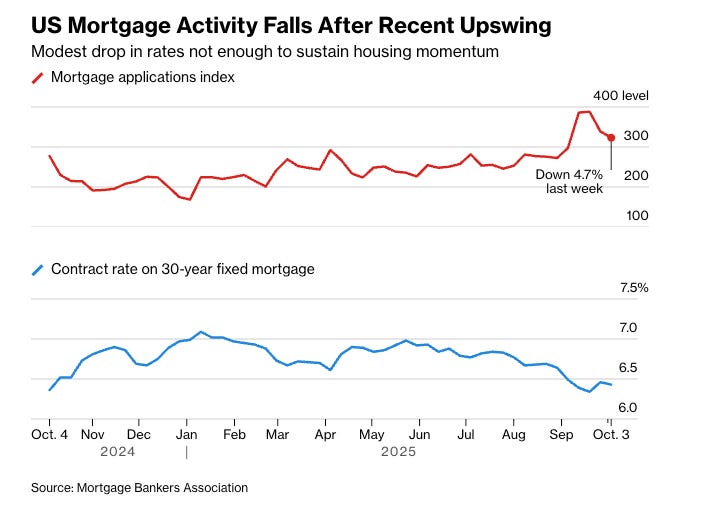
⛓️ Supply chain pressures remain loose. The New York Fed’s Global Supply Chain Pressure Index — a composite of various supply chain indicators — ticked modestly higher in September and remains near historically normal levels. It’s way down from its December 2021 supply chain crisis high.
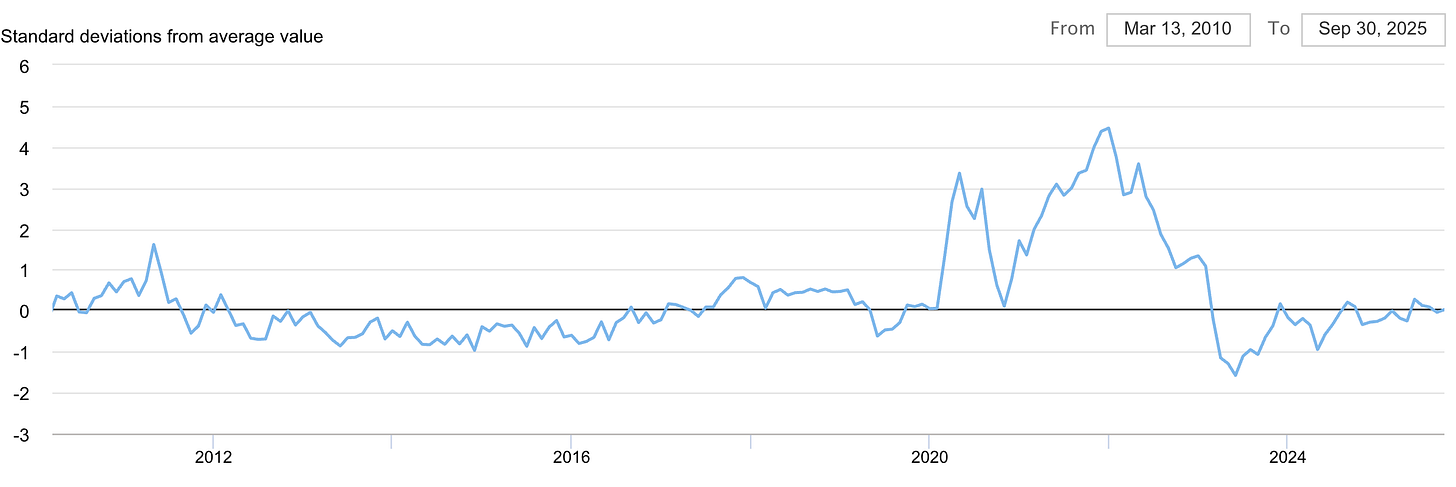
For more on the supply chain, read: We can stop calling it a supply chain crisis ⛓
Putting it all together 📋
🚨 The Trump administration’s pursuit of tariffs is disrupting global trade, with significant implications for the U.S. economy, corporate earnings, and the stock market. Until we get more clarity, here’s where things stand:
Earnings look bullish: The long-term outlook for the stock market remains favorable, bolstered by expectations for years of earnings growth. And earnings are the most important driver of stock prices.
Demand is positive: Demand for goods and services remains positive, supported by healthy consumer and business balance sheets. Job creation, although cooling, also remains positive, and the Federal Reserve — having resolved the inflation crisis — shifted its focus toward supporting the labor market.
But growth is cooling: While the economy remains healthy, growth has normalized from much hotter levels earlier in the cycle. The economy is less “coiled” these days as major tailwinds like excess job openings and core capex orders have faded. It has become harder to argue that growth is destiny.
Actions speak louder than words: We are in an odd period, given that the hard economic data decoupled from the soft sentiment-oriented data. Consumer and business sentiment has been relatively poor, even as tangible consumer and business activity continues to grow and trend at record levels. From an investor’s perspective, what matters is that the hard economic data continues to hold up.
Stocks are not the economy: There’s a case to be made that the U.S. stock market could outperform the U.S. economy in the near term, thanks largely to positive operating leverage. Since the pandemic, companies have aggressively adjusted their cost structures. This came with strategic layoffs and investment in new equipment, including hardware powered by AI. These moves are resulting in positive operating leverage, which means a modest amount of sales growth — in the cooling economy — is translating to robust earnings growth.
Mind the ever-present risks: Of course, we should not get complacent. There will always be risks to worry about, such as U.S. political uncertainty, geopolitical turmoil, energy price volatility, and cyber attacks. There are also the dreaded unknowns. Any of these risks can flare up and spark short-term volatility in the markets.
Investing is never a smooth ride: There’s also the harsh reality that economic recessions and bear markets are developments that all long-term investors should expect as they build wealth in the markets. Always keep your stock market seat belts fastened.
Think long-term: For now, there’s no reason to believe there’ll be a challenge that the economy and the markets won’t be able to overcome over time. The long game remains undefeated, and it’s a streak that long-term investors can expect to continue.
For more on how the macro story is evolving, check out the previous review of the macro crosscurrents. »
Key insights about the stock market 📈
Here’s a roundup of some of TKer’s most talked-about paid and free newsletters about the stock market. All of the headlines are hyperlinked to the archived pieces.
10 truths about the stock market 📈
The stock market can be an intimidating place: It’s real money on the line, there’s an overwhelming amount of information, and people have lost fortunes in it very quickly. But it’s also a place where thoughtful investors have long accumulated a lot of wealth. The primary difference between those two outlooks is related to misconceptions about the stock market that can lead people to make poor investment decisions.
The makeup of the S&P 500 is constantly changing 🔀
Passive investing is a concept usually associated with buying and holding a fund that tracks an index. And no passive investment strategy has attracted as much attention as buying an S&P 500 index fund. However, the S&P 500 — an index of 500 of the largest U.S. companies — is anything but a static set of 500 stocks.

The key driver of stock prices: Earnings💰
For investors, anything you can ever learn about a company matters only if it also tells you something about earnings. That’s because long-term moves in a stock can ultimately be explained by the underlying company’s earnings, expectations for earnings, and uncertainty about those expectations for earnings. Over time, the relationship between stock prices and earnings has a very tight statistical relationship.
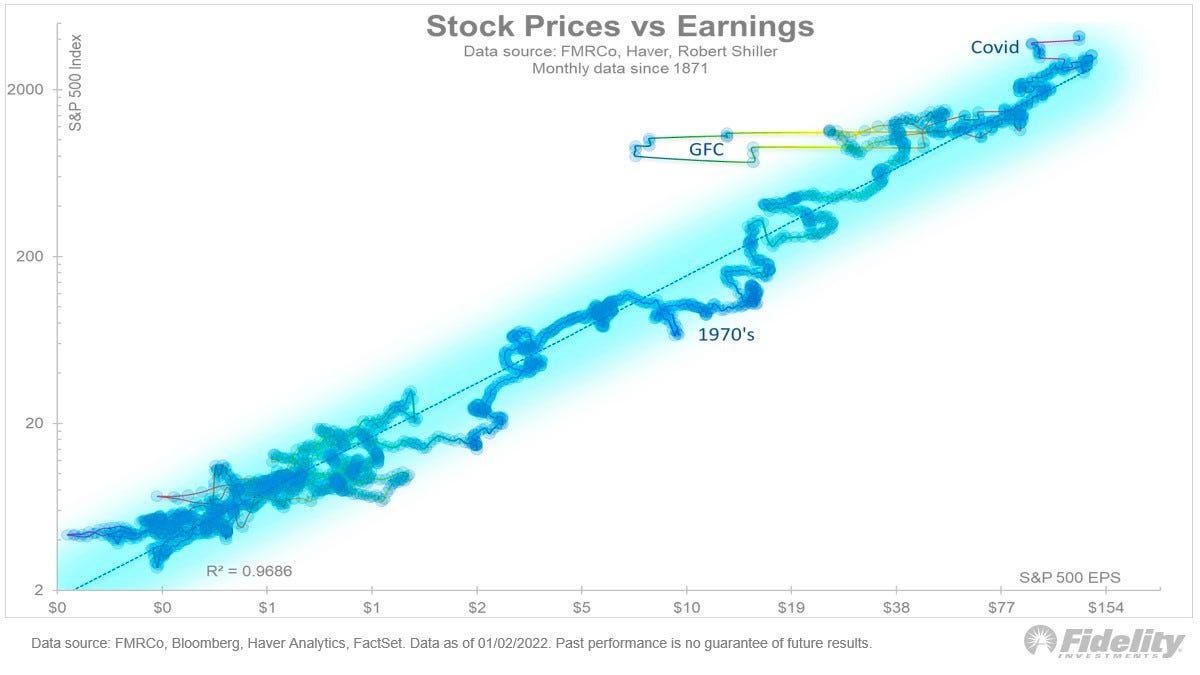
Stomach-churning stock market sell-offs are normal🎢
Investors should always be mentally prepared for some big sell-offs in the stock market. It’s part of the deal when you invest in an asset class that is sensitive to the constant flow of good and bad news. Since 1950, the S&P 500 has seen an average annual max drawdown (i.e., the biggest intra-year sell-off) of 14%.
How the stock market performed around recessions 📉📈
Every recession in history was different. And the range of stock performance around them varied greatly. There are two things worth noting. First, recessions have always been accompanied by a significant drawdown in stock prices. Second, the stock market bottomed and inflected upward long before recessions ended.

In the stock market, time pays ⏳
Since 1928, the S&P 500 has generated a positive total return more than 89% of the time over all five-year periods. Those are pretty good odds. When you extend the timeframe to 20 years, you’ll see that there’s never been a period where the S&P 500 didn’t generate a positive return.

What a strong dollar means for stocks 👑
While a strong dollar may be great news for Americans vacationing abroad and U.S. businesses importing goods from overseas, it’s a headwind for multinational U.S.-based corporations doing business in non-U.S. markets.

Stanley Druckenmiller's No. 1 piece of advice for novice investors 🧐
…you don't want to buy them when earnings are great, because what are they doing when their earnings are great? They go out and expand capacity. Three or four years later, there's overcapacity and they're losing money. What about when they're losing money? Well, then they’ve stopped building capacity. So three or four years later, capacity will have shrunk and their profit margins will be way up. So, you always have to sort of imagine the world the way it's going to be in 18 to 24 months as opposed to now. If you buy it now, you're buying into every single fad every single moment. Whereas if you envision the future, you're trying to imagine how that might be reflected differently in security prices.
Peter Lynch made a remarkably prescient market observation in 1994 🎯
Some event will come out of left field, and the market will go down, or the market will go up. Volatility will occur. Markets will continue to have these ups and downs. … Basic corporate profits have grown about 8% a year historically. So, corporate profits double about every nine years. The stock market ought to double about every nine years… The next 500 points, the next 600 points — I don’t know which way they’ll go… They’ll double again in eight or nine years after that. Because profits go up 8% a year, and stocks will follow. That's all there is to it.
Warren Buffett's 'fourth law of motion' 📉
Long ago, Sir Isaac Newton gave us three laws of motion, which were the work of genius. But Sir Isaac’s talents didn’t extend to investing: He lost a bundle in the South Sea Bubble, explaining later, “I can calculate the movement of the stars, but not the madness of men.” If he had not been traumatized by this loss, Sir Isaac might well have gone on to discover the Fourth Law of Motion: For investors as a whole, returns decrease as motion increases.
Most pros can’t beat the market 🥊
According to S&P Dow Jones Indices (SPDJI), 65% of U.S. large-cap equity fund managers underperformed the S&P 500 in 2024. As you stretch the time horizon, the numbers get even more dismal. Over a three-year period, 85% underperformed. Over a 10-year period, 90% underperformed. And over a 20-year period, 92% underperformed. This 2023 performance follows 14 consecutive years in which the majority of fund managers in this category have lagged the index.
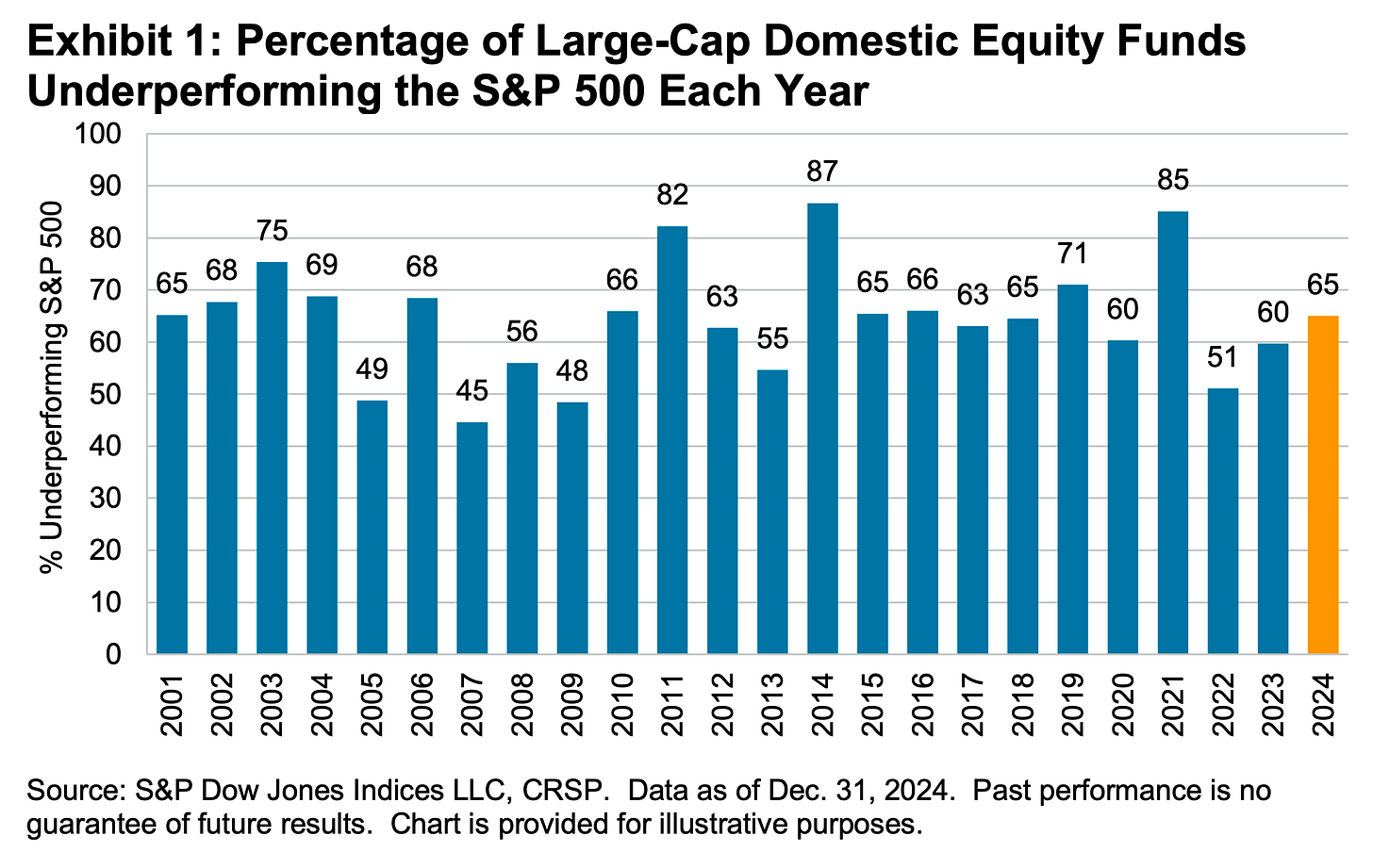
Proof that 'past performance is no guarantee of future results' 📊
Even if you are a fund manager who generated industry-leading returns in one year, history says it’s an almost insurmountable task to stay on top consistently in subsequent years. According to S&P Dow Jones Indices, just 4.21% of all U.S. equity funds in the top half of performance during the first year were able to remain in the top during the four subsequent years. Only 2.42% of U.S. large-cap funds remained in the top half
SPDJI’s report also considered fund performance relative to their benchmarks over the past three years. Of 738 U.S. large-cap equity funds tracked by SPDJI, 50.68% beat the S&P 500 in 2022. Just 5.08% beat the S&P in the two years ending 2023. And only 2.14% of the funds beat the index over the three years ending in 2024.

The odds are stacked against stock pickers 🎲
Picking stocks in an attempt to beat market averages is an incredibly challenging and sometimes money-losing effort. Most professional stock pickers aren’t able to do this consistently. One of the reasons for this is that most stocks don’t deliver above-average returns. According to S&P Dow Jones Indices, only 19% of the stocks in the S&P 500 outperformed the average stock’s return from 2001 to 2025. Over this period, the average return on an S&P 500 stock was 452%, while the median stock rose by just 59%.
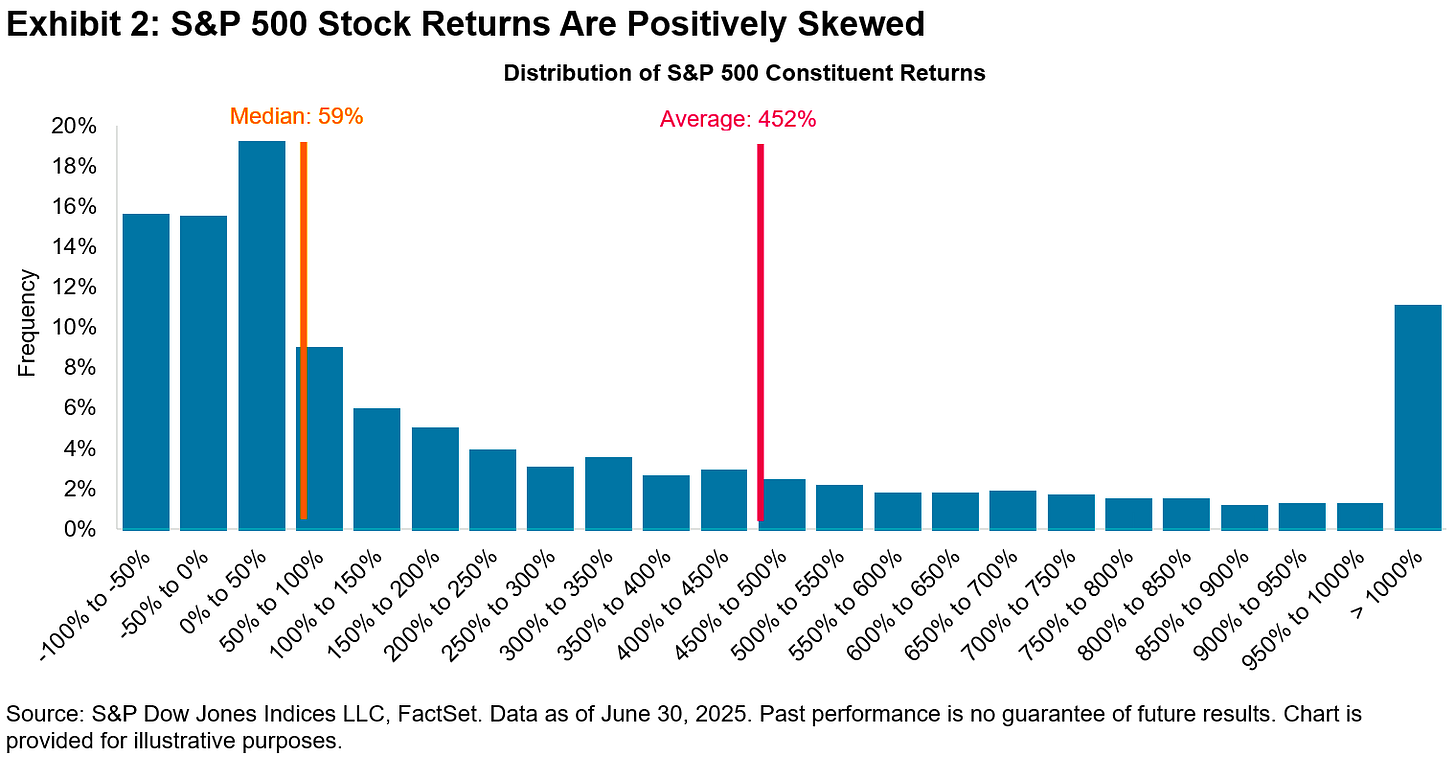



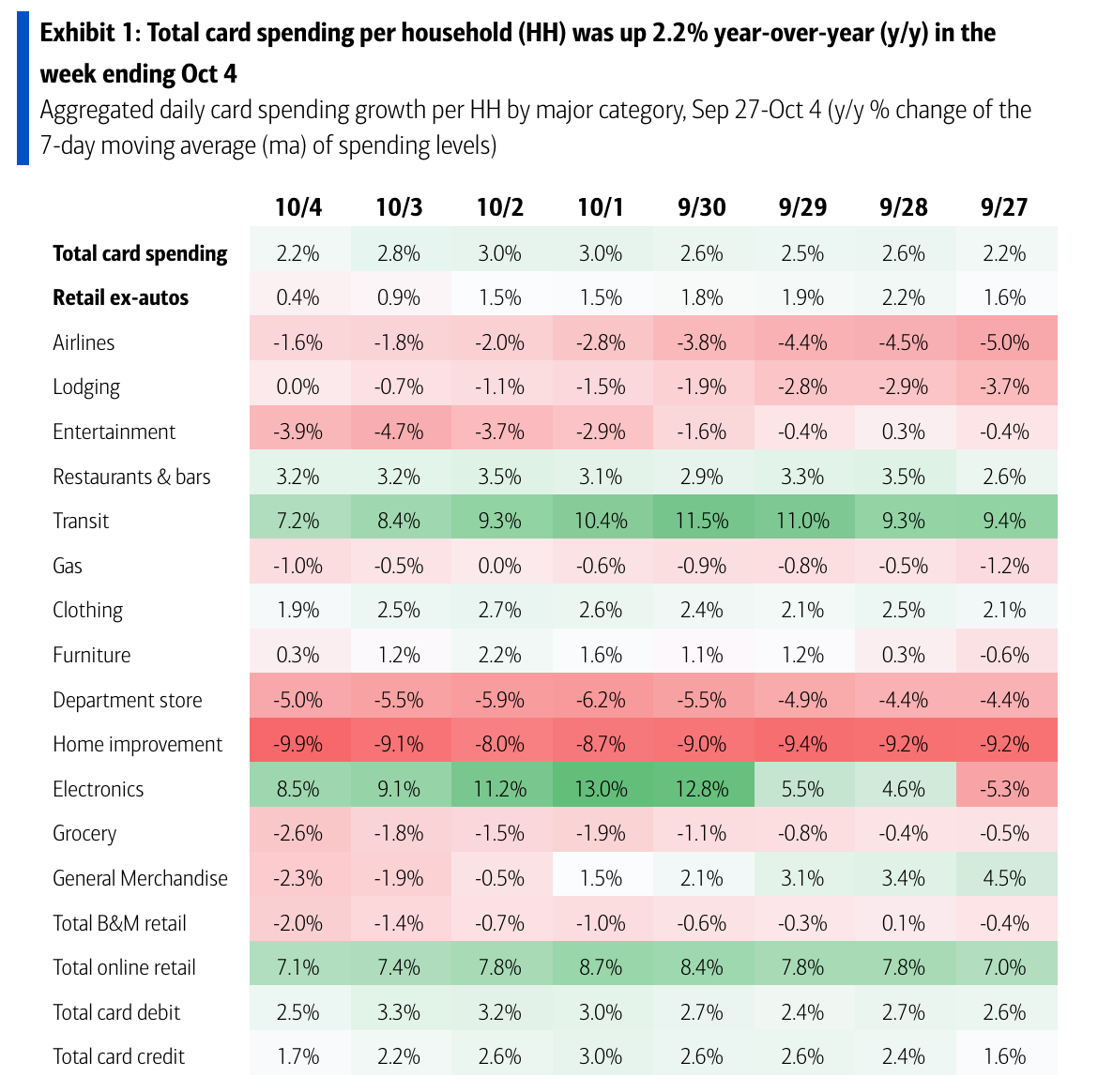
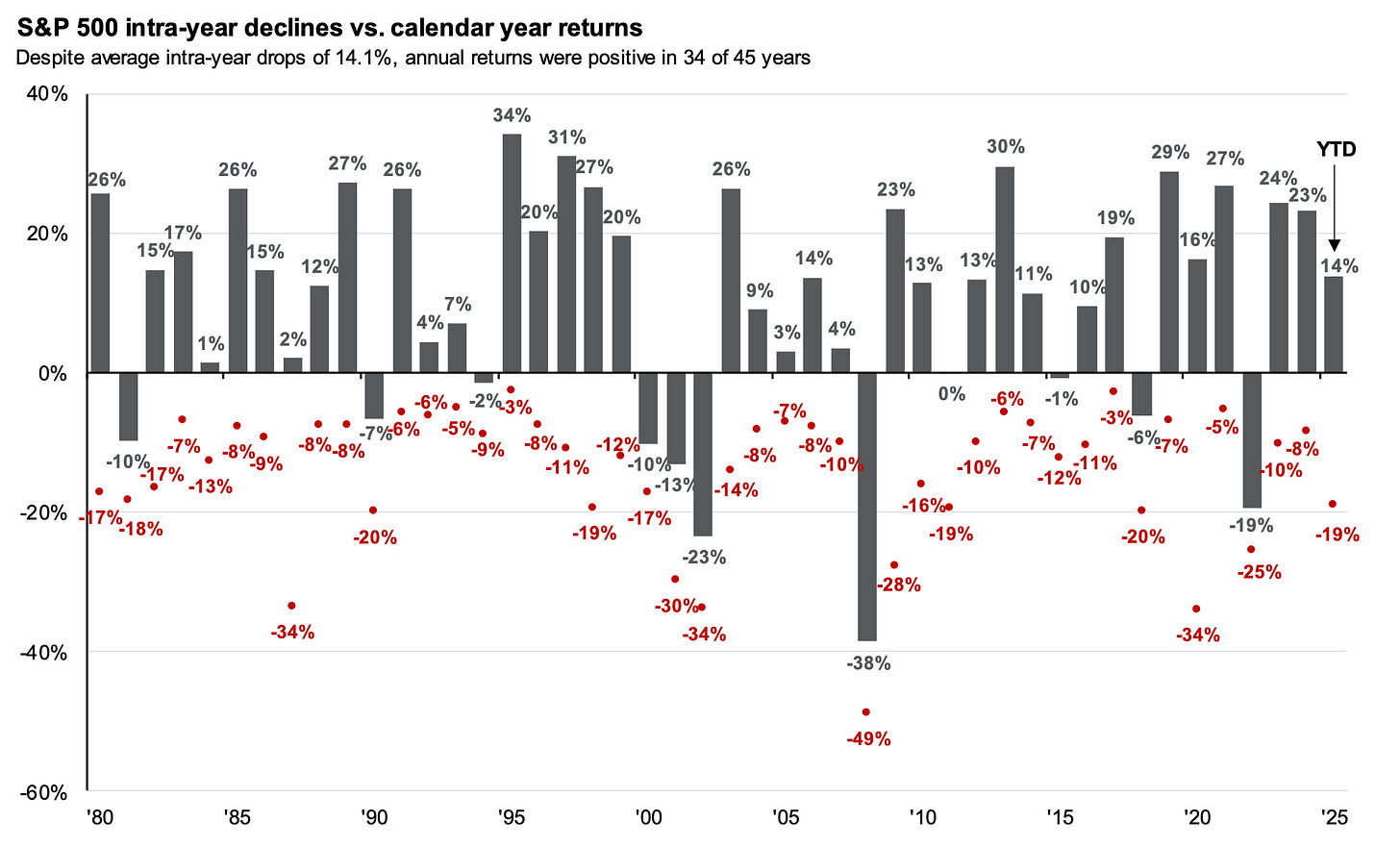
You might consider defining bullish as expecting a 25% increase since it is the reciprocal of a 20% decrease, e.g. it takes 25% increase to offset a 20% decrease and vice versa...